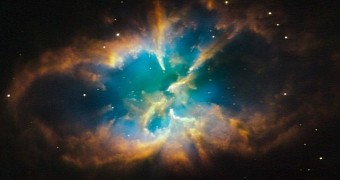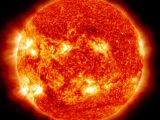A paper published in yesterday's issue of the journal Nature and authored by researchers with UK's University of Hertfordshire describes a so-called cosmic blowout documented in a distant galaxy dubbed SDSS J0905+57.
The astronomers behind this investigation detail that this galaxy is now coughing out dense gas at warp speed. What's more, they say that the gas originating from this celestial system extends tens of thousands of light-years into space.
Seeing how galaxies need gas to birth new stars, there is no doubt that this galactic blowout will influence the evolution of SDS J0905+57. In fact, specialists argue that, at some point in the future, star-forming processes in the galaxy might end.
Zooming in on a cosmic blowout
As detailed in the journal Nature, while studying the galaxy with the help of the Institut de Radioastronomie Millimétrique (IRAM) Plateau de Bure Interferometer, the University of Hertfordshire scientists found that SDS J0905+57 is losing gas at a rapid pace.
In case anyone was wondering, the Institut de Radioastronomie Millimétrique (IRAM) Plateau de Bure Interferometer is the really fancy name of a radio telescope that is based in the French Alps.
Interestingly enough, the astronomers documented the jets of dense gas blasting out of this galaxy quite accidentally. Thus, they say that, when they turned their attention to SDSS J0905+57, they merely wanted to study the galaxy's gas reserves.
“This discovery highlights the serendipity of scientific research. Originally we were simply trying to measure the amount of dense gas in SDSS J0905+57,” Dr. James Geach said in a statement.
“What we found was something surprising – a large fraction of the gas is being blasted out of the galaxy by the concentration of stars forming at the galaxy's center,” the University of Hertfordshire astronomer went on to detail.
The gas jets are moving at warp speed
Dr. James Geach and colleagues say that, according to data obtained with the help of the Institut de Radioastronomie Millimétrique (IRAM) Plateau de Bure Interferometer, gas is now leaving SDSS J0905+57 at a speed of 2 million miles per hour (3.2 million kilometers per hour).
The astronomer and his colleagues explain that this is chiefly because of the pressure exerted on it by the radiation emitted by stars now forming deep inside the galaxy's core. The same pressure is causing the gas to extend to tens of thousands of light-years into space.
It is estimated that the gas now leaving this distant galaxy would be more than enough to form about one billion stars similar to the Sun that stands at the core of our Solar System.
As mentioned, scientists are convinced that, in time, SDSS J0905+57 will lose so much gas that it will no longer be able to sustain star-forming processes. It is believed that, by studying the behavior of this galaxy, astronomers will gain a better understanding of the evolution of the universe.

 14 DAY TRIAL //
14 DAY TRIAL // 



